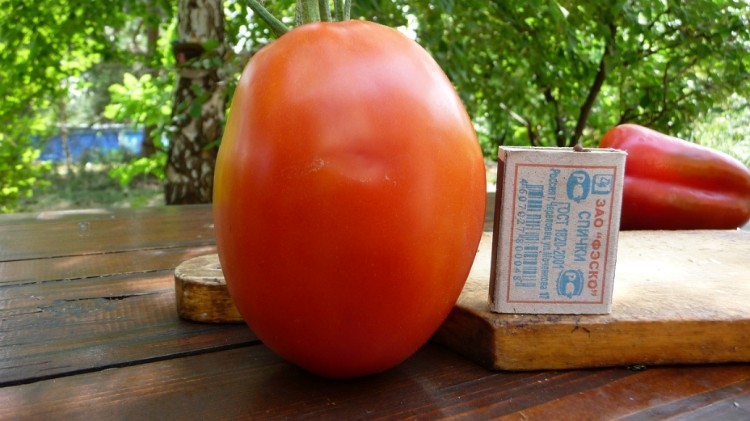 This variety of Brazilian selection has proven itself in the vastness of Russia for a long time. In a special introduction for gardeners with experience does not need. He is loved for unpretentiousness in leaving, an abundance of large tasty fruits.
This variety of Brazilian selection has proven itself in the vastness of Russia for a long time. In a special introduction for gardeners with experience does not need. He is loved for unpretentiousness in leaving, an abundance of large tasty fruits.
The main drawback is the ability to successfully grow de Barao giant only having a greenhouse on the site.
Content
general characteristics
- It is considered medium late, but, as practice shows, the ripening dates are closer to late. The period from the appearance of seedlings to the ripening of the first fruits is 123-128 days.
- Super tall: can grow up to 270 cm in height!
- Not a hybrid variety, Brazilian selection.
- Indeterminate. It is actively growing in height and in the sides, therefore, mandatory stepsoning will be required. And also - pinching the tops of the bushes in the last days of August, so that the plant does not spend energy on the formation of new flowers and fruits, but nourishes well that have already begun, then they will have time to ripen before the onset of cold weather.
- Needs a mandatory garter throughout the growing season.
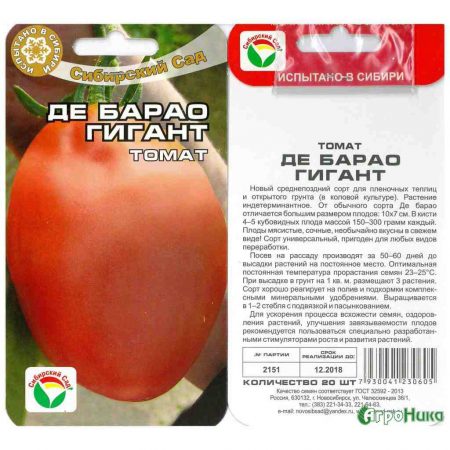
- In the temperate latitudes of the middle strip, it is suitable only for greenhouse cultivation. It makes sense to plant in open ground only in the very south of the Russian Federation.
- The leaves are green, the usual form for tomatoes.
- The fruits are large, elongated, plum-like, in some, a funny “nose” is formed on the tip. Not very large - up to 350 g each.
- The texture is dense, fleshy, juicy, very tasty.
- Moreover, in general, the yield of the variety is quite high: up to 11 fruits are formed in each brush with proper care. From 1 square meter of tomato plantation, you can collect about 20-22 kg of tomatoes.
- The fruits are suitable for pickling, as well as for eating fresh, making juices from them.
Advantages and disadvantages
- The fruits are perfectly tied even with not very careful care.
- Harvest is perfectly stored and transported, keeping the presentation.
- The variety bears fruit for a very long time - before the start of frost in October.
- With proper agricultural technology, diseases are rarely affected.
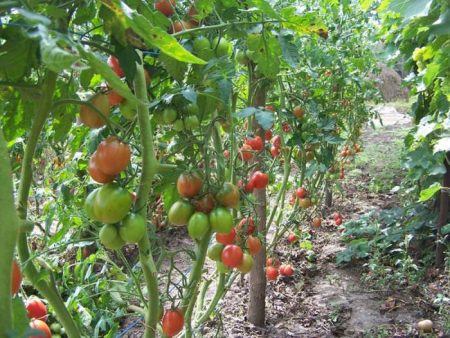
- Medium-late or even late ripening. If the ripening of the fruits is late - there is a risk of catching late blight, which begins to develop with lower temperatures and increased air humidity.
- Quite high yield of the bush.
- The ability to grow this variety only in greenhouse conditions.
- The small size of the fruit.
Growing seedlings
- Sow the seeds 60-65 days before diving into the greenhouse.
- Before sowing, they should be soaked for at least a couple of hours. Surfaced, darkened seeds are not suitable for sowing. It’s nice to try to awaken them with a “contrast shower”: first, pour hot water (about +50 degrees), then cold. Repeat this 3-4 times, after which - sow. Alternatively, you can use biostimulants - "HB-101", "Epin", "Zircon".
- In order not to injure the root system once again with transplants, you can sow the seeds immediately in separate seedling cups (peat ones are perfect).
- One of the best soil options is from the beds on which siderata grew last season - mustard, peas, beans, beans, lupins. 1/3 of coarse sand should be added to it. It is good to add to the mixture 1 cup of wood ash, 15 grams of potassium chloride and nitrogen fertilizer (for example, "Urea")
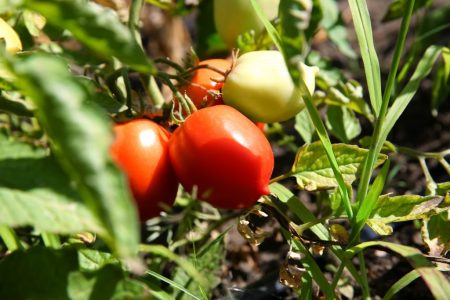
- Before sowing, the soil must also be treated - disinfected with "Maxim", a pink solution of potassium permanganate.You can buy in the pharmacy "Furacilin" (an antifungal drug designed to treat people), chop 1 tablet, dissolve in 1 liter of water and moisten the soil with plenty.
- Before seedlings appear, crops should be kept covered with glass or a transparent plastic film to create a greenhouse effect. Temperature for seed germination - + 20-23 degrees. At this time, it is important to monitor soil moisture. The soil should not dry out, but the water should not stand in it either, otherwise the seeds in it will “suffocate”.
- For growing seedlings, the usual care is: periodic irrigation without flooding the soil, loosening the soil, applying fertilizing. The first is after the appearance of the first true leaf. It is best to apply complex mineral fertilizers (without the dominant nitrogen component!). Doses - 2 times less than recommended in the instructions. Before applying fertilizers, it is important to shed seedlings abundantly: chemical compounds are well absorbed by the roots only in the form dissolved in water.
Folk dressing for tomato seedlings
Eggs from 4-5 eggs should be placed in a 3-liter jar, pour water and tightly close the lid. The jar should be in the dark. After 3 days, the infusion becomes cloudy, it is ready for use. Top dressing is very effective: it gives an excellent impetus to the rapid development and growth of seedlings. But you need to be prepared for the cost: the smell when watering the apartment will spread extremely unpleasant, characteristic of the hydrogen sulfide released during decomposition.
- Tomato seedlings need a lot of sunlight, it should be grown on the most lighted window sill. On the hottest days, shade from direct scorching sunlight.
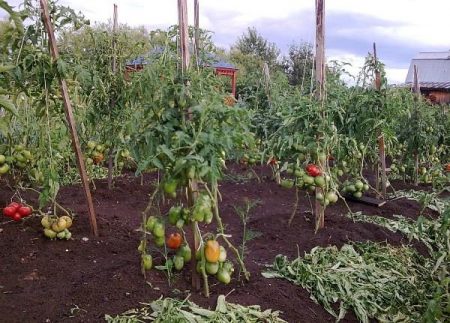
- Before planting in a greenhouse, it is better to harden the seedlings, i.e. accustom to open air and lower temperatures, especially at night. For this, the plants are taken out to fresh air, first for a couple of hours, then left on the balcony or in the yard longer. And finally, leave to sleep. The entire hardening process can take up to 2 weeks.
Tip: if seedlings outgrew
If the street has cool weather for a long time in the second half of spring, nightly return frosts are periodically repeated, tomato seedlings cannot be planted in the greenhouse. But on the windowsill, it begins to outgrow, stretch, the trunks of seedlings are bent. Seedling owners are upset. In fact, there is nothing wrong with that. And even vice versa.
On overgrown stems, additional roots begin to form. It is important when planting in open ground to deepen them. Then the root system of the bush will be more voluminous, more powerful, the bush will be able to receive additional nutrition thanks to it. Which, undoubtedly, will positively affect the harvest.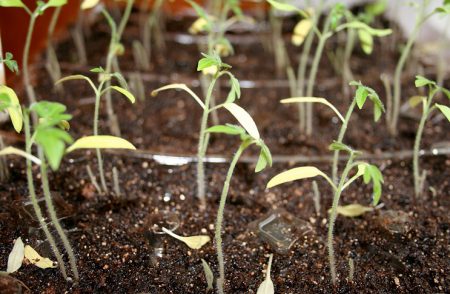
Tomato care in the greenhouse
- Tomatoes need to be transplanted into the greenhouse when daytime temperatures are set at + 15-18 degrees. and the threat of nighttime freezing frost passes.
- The beds in the greenhouse can be prepared since the fall, bringing horse manure into them (in a bucket of 1 sq.m.). Or - a complex mineral fertilizer (dose - according to the instructions attached to it). Tomatoes are very fond of growing on a "warm bed" of manure. Untreated manure (not only horse, but also goat, cow) or undiluted bird droppings is laid at the bottom of the landing holes. It is only important to lay the heating bed at a sufficient depth (at least 35-40 cm) so that the roots do not immediately reach it and do not get burns. An excellent filling of the planting holes is a 4-year-old compost.
- The scheme of planting tomato seedlings 50X50. Practice shows that the crop is better if 1 square. meter grow no more than 3-4 bushes.
- After a week, planted tomatoes should be tied up. And do it as they grow up regularly.
- Growing this tomato variety is most productive in just 2 trunks. The very first stepson must be left, the rest to break off. Leaves should also be cut off: to the first fruit brush - everything, above it - through one.When all the fruits are poured, it is better to destroy all the leaves on the bushes. So there will be much less risk of catching late blight, and this will also contribute to a better and faster ripening of the fruits.
- If the ridges were thoroughly prepared, it is important not to overdo it with the introduction of nitrogen fertilizers. Organic matter is also rich in nitrogen, including the mullein infusion, beloved by all gardeners. If the plant is overfed with nitrogen, it will drive the foliage to the detriment of flowering and ripening of the fruit. In addition, it will become especially prone to disease and pest damage.
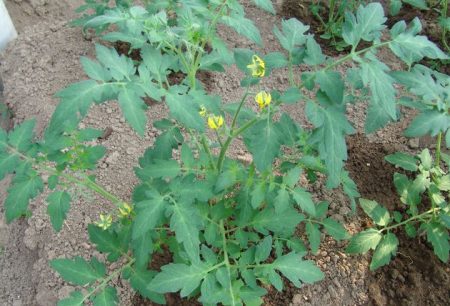
- In addition to top dressing with mineral and organic fertilizers, tomato, foliar top dressings with an aqueous solution of boric acid (1 g / 1l) will be useful. Due to this, more ovaries form on the bushes, the fruits form faster and better. Spraying begins at the moment of formation of the first flower brushes and is repeated all season every 7-10 days.
Tip: if the fruits ripen for too long
Spraying the bushes with water infusion of iodine will help to speed up the process. 4 drops of the drug are diluted in 3-4 liters of warm water. Each bush should get at least 2 tablespoons.
- For prevention from late blight, you can spray the bushes with an aqueous solution of whey (1 liter of serum in a 12-liter bucket of water). It will not be worse if treated with undiluted serum in water. Spraying should be repeated until the end of the growing season with an interval of 10-14 days. Powder dusting with wood ash also helps protect plants from phytophthora (1 time in 10-14 days). It is possible to sprinkle with it not only the “legs” of the bush, but its entirety.
- Tomatoes like quite plentiful watering, but not excessive. Watering is by no means in the middle of a hot day. Better - in the evening, or at any time of the day if the weather is cloudy. After the procedure, it is important to open the greenhouse wide and ventilate well, otherwise there is a great risk of developing infectious diseases in high humidity conditions.
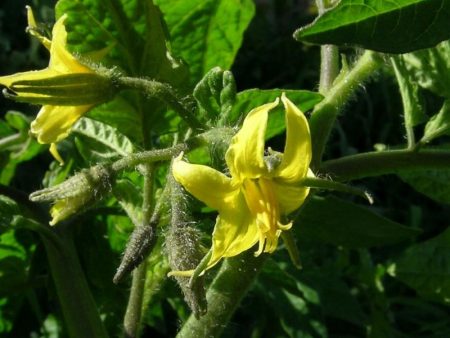
Tip: if the fruits crack
This problem often occurs when growing tomatoes with large fruits and delicate skin on them. It is primarily associated with one-time excessive watering. Tomatoes are able to quickly absorb large volumes of water. Many gardeners simply put a hose in the greenhouse, turn on the water and go about their business. And on the tomato beds "flood" begins. Tomato bushes at a time absorb a huge amount of moisture, as a result of which the shell of the fruit, and sometimes even the stems, do not stand up and form the so-called “moisture warriors”.
Especially this risk exists on heavy clay soils, not improved with sand and other loosening materials. Excellent yield on poorly permeable soils also:
- raised beds;
- drainage under the landings.
Well, of course, each bush should be given as much water as it can absorb without damage to the crop.
Reviews
Variety de Barao giant in the middle climatic zone is definitely suitable only for growing in greenhouses. I can say this because 3 years ago, without having carefully read the characteristics, it was stupid to put him in the open ground. I live in the city of Penza. The bushes grew long, thin, the fruit ripened - "one tooth." Do not do such stupid experiments!
Sergey Mikhailovich
Bushes are sweeping under 3 meters, each with 12-14 fruit brushes. But they ripen for a very long time.
It is quite convenient to pinch: foliage sparsely grows.
In August, I pinch plants at an altitude of 1.5. Half of the harvest by this time has already been harvested and laid out in banks. But unripe brushes still hang. Tomatoes can be poured until mid-October, if they do not break before freezing. The fruits are already not very beautiful, but then you can eat them almost until the end of November!
Natalya
De Barao giant is a good variety, quite tasty fruits. But he is already quite old. And I prefer more modern and advanced. Last year, the varieties of the last selection were sown in open ground on May 6. Everything grew perfectly, the harvest is excellent! I live in Samara.
Ilya Pavlovich




 Low-growing tomatoes, without pinching: 5 of the most delicious varieties
Low-growing tomatoes, without pinching: 5 of the most delicious varieties Why tomato seedlings grow poorly
Why tomato seedlings grow poorly We grow a tomato in a shell
We grow a tomato in a shell Growing tomatoes without watering according to the method of Kazarin
Growing tomatoes without watering according to the method of Kazarin